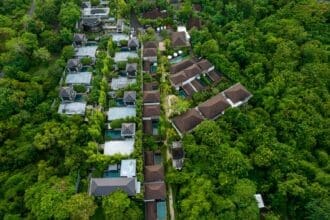Finding a climate-resilient property is the new leading strategy in international real estate, replacing the classic formula of “location, square footage, condition.” A new, “invisible” risk is changing the rules of the game. The devastating California wildfires in January 2025, which left thousands homeless, or the record-breaking floods in Central Europe, causing over €18 billion in damages, are no longer isolated events. They are the new reality, directly threatening the value, operational costs, and even the liquidity of assets. The traditional valuation model is no longer sufficient. Today, a strategic analysis of climate risk and the integration of resilience are the keys to long-term investment security.
Content
Redefining Risk: Global Trends and Local Consequences
Climate change is no longer an abstract concept; it has become a tangible financial risk for investors. Global trends show a clear escalation of extreme weather events that have a direct impact on the property market.
Floods, Fires, and Resource Scarcity
Recent examples are stark. The 2024-2025 floods in Central Europe affected hundreds of thousands of people and caused economic damage comparable to the GDP of a small country. Meanwhile, fires of unprecedented scale have swept across different parts of the world. In January 2025, California experienced 14 devastating fires, and in the summer of the same year, Turkey’s Mediterranean coast declared entire regions as “disaster zones.” According to data from the U.S. National Oceanic and Atmospheric Administration (NOAA), the risk of such events will only increase.
The “Uninsurable Property” Phenomenon
One of the most alarming side effects of this risk is the rise of the so-called “uninsurable property.” In areas at high risk of floods or fires, insurance companies are increasingly refusing to issue policies or are offering economically unfeasible premiums. This places investors in an extremely vulnerable position—the property becomes difficult to sell, impossible to mortgage, and represents a massive liability in the event of a disaster. Choosing the right partner and agent can protect you from such hidden risks.
The Return on Resilience: Financial Benefits Behind Physical Protection
Investing in a climate-resilient property is not just a defensive expense but a strategic move with a clear financial return. Smart investors now understand that resilience is directly linked to lower costs, higher value, and a better market position.
CapEx vs. OpEx: The Long-Term Calculation
The initial investment (Capital Expenditure – CapEx) in higher-quality, durable materials—such as fire-resistant roofing, energy-efficient windows, or improved waterproofing—leads to significantly lower operating expenses (OpEx) in the future. Smaller energy bills, lower insurance premiums, and a drastically reduced risk of costly post-disaster repairs turn the initial outlay into a profitable investment.
Total Cost of Ownership (TCO) and Risk Arbitrage
The purchase price is just the tip of the iceberg. The Total Cost of Ownership (TCO) includes all expenses for maintenance, insurance, taxes, and potential costs for climate adaptation. Properties not designed with the future in mind carry hidden costs that can erode the entire return on investment. This is where the concept of risk arbitrage comes in: paying a 5-10% premium today for a property that meets high resilience standards is far more sensible than taking on the risk of a 50-100% loss in value tomorrow.
A Practical Checklist for the Informed Investor
Assessing climate resilience requires a new approach and attention to details that were previously overlooked. Whether you are considering an investment in a Dubai property or in another international market, here are the key aspects to verify:
- Flood Risk: Check historical flood data and maps for the area. Assess the quality of the waterproofing, the drainage systems around the property, and the presence of protective infrastructure in the region.
- Materials and Construction: Request documents certifying compliance with seismic and fire-resistance standards. Check the quality of the concrete, insulation, and the fire-resistance rating of key structural elements.
- Building Envelope: High-quality windows, insulated facade systems, and durable plaster are the first line of defense against extreme temperatures, wind, and moisture.
- System Autonomy: The presence of solar panels, rainwater harvesting systems, or a backup power supply (generator) transforms the property from a passive to an active asset during a crisis.
- Certifications and Ratings: Look for international certifications like LEED or BREEAM. Specialized Climate Resilience Scores are also becoming increasingly popular.
- Insurance Accessibility: Before purchasing, investigate whether the property can be insured against specific risks (flood, wildfire) and what the terms are.
Conclusion: The New Paradigm in Property Valuation
The revolution in international property valuation is already here. Resilience is no longer a bonus; it is becoming a key criterion, on par with location. In the near future, access to financing and insurance will be increasingly tied to the proven resilience of assets. Investing in a climate-resilient property is not merely a protective measure but an investment advantage. It is a strategy that ensures your capital not only survives but thrives in an uncertain future.
You might also like:
- Abu Dhabi property market Q1 2025: a paradox or a sign of maturation?
- Investing in Dubai: Beyond the glamour – the real risks for your Palm apartment
- What to check before a property deal in Spain: your guide to a secure purchase
This post is also available in: Български







